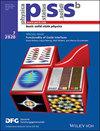六方锑化镓 CaAgAs 中的线节点狄拉克半金属和拓扑绝缘相的热电特性
IF 1.8
4区 物理与天体物理
Q3 PHYSICS, CONDENSED MATTER
引用次数: 0
摘要
本文采用具有自旋轨道耦合(SOC)的密度泛函理论和玻尔兹曼输运理论,研究了最近预测的拓扑节点线半金属 CaAgAs 的结构、电子和输运特性。由于自旋轨道耦合效应,该材料呈现出从结线半金属到拓扑绝缘体(TI)的拓扑相变。Voigt-Reuss-Hill 近似用于计算各种机械性能。计算得出的塞贝克系数≈153.19 μV K-1、功率因数≈5.9 × 1011 W m-1 K-2 s-1和晶格热导率≈6.20 W m-1 K-1表明,与其他著名的热电材料相比,钙钛矿具有更优越的热电性能。这些发现反映了 CaAgAs 作为热电材料的潜力,这归功于 SOC 诱导的拓扑相变。本文章由计算机程序翻译,如有差异,请以英文原文为准。
Thermoelectric Properties of Line‐Node Dirac Semimetal and Topological Insulating Phase in Hexagonal Pnictide CaAgAs
The structural, electronic, and transport properties of CaAgAs, a recently predicted topological nodal line semimetal, are investigated using density‐functional theory with spin–orbit coupling (SOC) and Boltzmann transport theory. The material exhibits a topological phase transition from a nodal line semimetal to a topological insulator (TI) phase as a result of the SOC effect. The Voigt–Reuss–Hill approximation is used to compute various mechanical properties. The calculated Seebeck coefficient ≈153.19 μV K−1 , power factor ≈5.9 × 1011 W m−1 K−2 s−1 , and lattice thermal conductivity ≈6.20 W m−1 K−1 suggest that CaAgAs have superior thermoelectric performance compared to other well‐known predicted thermoelectric materials. The calculated value of figure of merit for without (NSOC) is 0.34, which increases to 0.43 with SOC at 500 K. In these findings, the potential of CaAgAs is reflected as a thermoelectric material, attributed to the topological phase transition induced by SOC.
求助全文
通过发布文献求助,成功后即可免费获取论文全文。
去求助
来源期刊
CiteScore
3.30
自引率
6.20%
发文量
321
审稿时长
2 months
期刊介绍:
physica status solidi is devoted to the thorough peer review and the rapid publication of new and important results in all fields of solid state and materials physics, from basic science to applications and devices. Being among the largest and most important international publications, the pss journals publish review articles, letters and original work as well as special issues and conference contributions.
physica status solidi b – basic solid state physics is devoted to topics such as theoretical and experimental investigations of the atomistic and electronic structure of solids in general, phase transitions, electronic and optical properties of low-dimensional, nano-scale, strongly correlated, or disordered systems, superconductivity, magnetism, ferroelectricity etc.

 求助内容:
求助内容: 应助结果提醒方式:
应助结果提醒方式:


